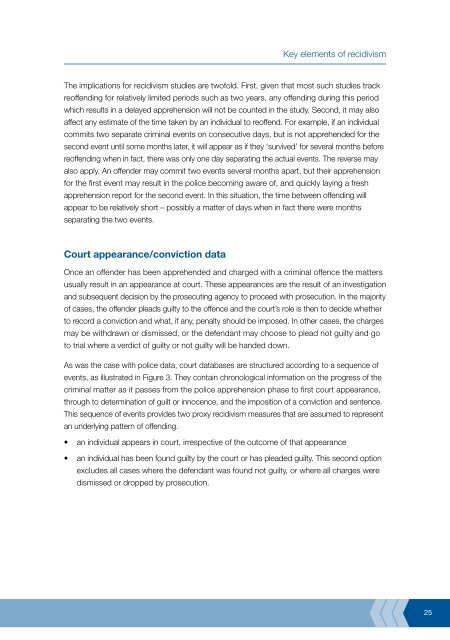Recidivism in Australia : findings and future research - Australian ...
Recidivism in Australia : findings and future research - Australian ...
Recidivism in Australia : findings and future research - Australian ...
You also want an ePaper? Increase the reach of your titles
YUMPU automatically turns print PDFs into web optimized ePapers that Google loves.
The implications for recidivism studies are twofold. First, given that most such studies track<br />
reoffend<strong>in</strong>g for relatively limited periods such as two years, any offend<strong>in</strong>g dur<strong>in</strong>g this period<br />
which results <strong>in</strong> a delayed apprehension will not be counted <strong>in</strong> the study. Second, it may also<br />
affect any estimate of the time taken by an <strong>in</strong>dividual to reoffend. For example, if an <strong>in</strong>dividual<br />
commits two separate crim<strong>in</strong>al events on consecutive days, but is not apprehended for the<br />
second event until some months later, it will appear as if they ‘survived’ for several months before<br />
reoffend<strong>in</strong>g when <strong>in</strong> fact, there was only one day separat<strong>in</strong>g the actual events. The reverse may<br />
also apply. An offender may commit two events several months apart, but their apprehension<br />
for the first event may result <strong>in</strong> the police becom<strong>in</strong>g aware of, <strong>and</strong> quickly lay<strong>in</strong>g a fresh<br />
apprehension report for the second event. In this situation, the time between offend<strong>in</strong>g will<br />
appear to be relatively short – possibly a matter of days when <strong>in</strong> fact there were months<br />
separat<strong>in</strong>g the two events.<br />
Court appearance/conviction data<br />
Once an offender has been apprehended <strong>and</strong> charged with a crim<strong>in</strong>al offence the matters<br />
usually result <strong>in</strong> an appearance at court. These appearances are the result of an <strong>in</strong>vestigation<br />
<strong>and</strong> subsequent decision by the prosecut<strong>in</strong>g agency to proceed with prosecution. In the majority<br />
of cases, the offender pleads guilty to the offence <strong>and</strong> the court’s role is then to decide whether<br />
to record a conviction <strong>and</strong> what, if any, penalty should be imposed. In other cases, the charges<br />
may be withdrawn or dismissed, or the defendant may choose to plead not guilty <strong>and</strong> go<br />
to trial where a verdict of guilty or not guilty will be h<strong>and</strong>ed down.<br />
As was the case with police data, court databases are structured accord<strong>in</strong>g to a sequence of<br />
events, as illustrated <strong>in</strong> Figure 3. They conta<strong>in</strong> chronological <strong>in</strong>formation on the progress of the<br />
crim<strong>in</strong>al matter as it passes from the police apprehension phase to first court appearance,<br />
through to determ<strong>in</strong>ation of guilt or <strong>in</strong>nocence, <strong>and</strong> the imposition of a conviction <strong>and</strong> sentence.<br />
This sequence of events provides two proxy recidivism measures that are assumed to represent<br />
an underly<strong>in</strong>g pattern of offend<strong>in</strong>g.<br />
•<br />
•<br />
Key elements of recidivism<br />
an <strong>in</strong>dividual appears <strong>in</strong> court, irrespective of the outcome of that appearance<br />
an <strong>in</strong>dividual has been found guilty by the court or has pleaded guilty. This second option<br />
excludes all cases where the defendant was found not guilty, or where all charges were<br />
dismissed or dropped by prosecution.<br />
25















